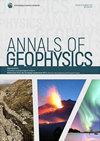用地震振幅比分析法监测埃特纳火山岩浆迁移
IF 1.2
4区 地球科学
Q3 GEOCHEMISTRY & GEOPHYSICS
引用次数: 0
摘要
将地震振幅比分析法(SARA)应用于2008年5月13日埃特纳火山喷发前6天的数据,以检验其作为预测属性的潜力。利用该方法,可以利用喷发点附近地震台网至少一对台站连续记录的振幅来确定岩浆迁移路径和地震迁移。由于每对台站计算的地震振幅比的突然变化,在主喷发前就探测到了地震的迁移趋势,以及深部的岩浆路径。还确定了地震群的开始和结束时间。达到类似结果的标准做法是使用火山震动,必须预先选择,从而降低效率并增加所需的时间。通过使用整个地震信号,该方法提供了一种更简单的半自动化替代方法,特别是对于地震事件或无法连续记录地震的地方。这种简单的方法有助于减少火山动荡期间危险岩浆传播的不确定性,因为它有助于提高定位地震群的准确性,并在喷发前确定岩浆运动的方向。我们还使用Mann-Kendall和Sen's估计量检验分析了幅值比趋势。这些测试结果证实,从喷发前一天开始,大多数对站都有积极的增加趋势。本文章由计算机程序翻译,如有差异,请以英文原文为准。
Monitoring magma migration at Mt. Etna using the Seismic Amplitude Ratio Analysis method
The Seismic Amplitude Ratio Analysis method (SARA) was applied to data recorded six days before the May 13, 2008 eruption of Mt. Etna to test its potential as a forecasting attribute. By using this method, the magma migration path, as well as the seismic migration, can be determined with the amplitude of continuous data recorded at least at one pair of stations from a seismic network near the eruption site. Due to the sudden changes in the seismic amplitude ratio calculated for each pair of stations, the seismic migration trend, as well as the magma path at depths, were detected before the main eruption. The start and end times of the seismic swarms were also determined. The standard practice to achieve similar results is to use volcanic tremors, which must be pre-selected thus reducing efficiency and increasing the time needed. By using the whole seismic signal, the method provides a simpler semi-automated alternative, especially for a seismic event or places where it is not possible to record tremors continuously. This simple method is useful to reduce uncertainties relative to hazardous magma propagation during volcanic unrest, as it helps improve the accuracy of locating seismic swarms and determining the direction of magma movement at depth before the eruption. We also analyzed the amplitude ratio trend using Mann-Kendall and Sen's estimator test. The results of these tests confirmed a positive and increasing trend from the day before the eruption in most pairs of stations.
求助全文
通过发布文献求助,成功后即可免费获取论文全文。
去求助
来源期刊

Annals of Geophysics
地学-地球化学与地球物理
CiteScore
2.40
自引率
0.00%
发文量
38
审稿时长
4-8 weeks
期刊介绍:
Annals of Geophysics is an international, peer-reviewed, open-access, online journal. Annals of Geophysics welcomes contributions on primary research on Seismology, Geodesy, Volcanology, Physics and Chemistry of the Earth, Oceanography and Climatology, Geomagnetism and Paleomagnetism, Geodynamics and Tectonophysics, Physics and Chemistry of the Atmosphere.
It provides:
-Open-access, freely accessible online (authors retain copyright)
-Fast publication times
-Peer review by expert, practicing researchers
-Free of charge publication
-Post-publication tools to indicate quality and impact
-Worldwide media coverage.
Annals of Geophysics is published by Istituto Nazionale di Geofisica e Vulcanologia (INGV), nonprofit public research institution.
 求助内容:
求助内容: 应助结果提醒方式:
应助结果提醒方式:


